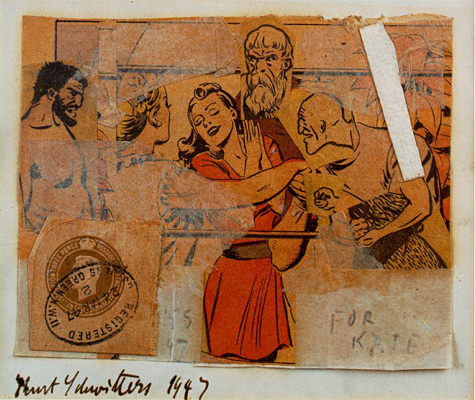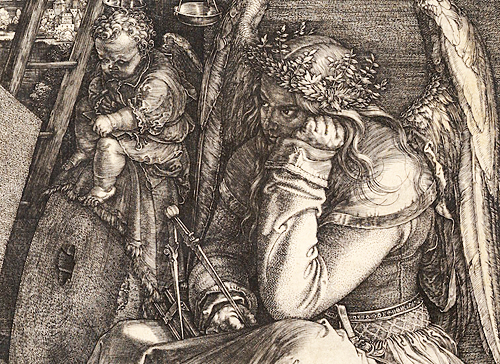In this wide-ranging lecture Kurt takes his class through a journey of myth, art, awareness and “the divinity within us.” Recorded in 1975, this lecture reflects Kurt’s interests at that time, and as such fairly represents themes he continued to explore for the rest of his life. Variously straight-forward and serious to convoluted and funny, over the course of one hour and twenty minutes he wanders across the terrain of physics, number theory, perception of color, linguistics, consciousness, the periodic table, gold, carbon and “whole systems.” (Note: There is a slight, intermittent buzzing in the recording but Kurt’s words are easily heard.)
UCLA Lecture 1967 - Renaissance to the Present
A 1967 lecture that begins as a very straightforward art history lecture about the Renaissance turns to Kurt’s concerns about teaching art history itself, and reflects upon the crisis in his own teaching career. His UCLA teaching contract terminated due to his controversial and unconventional teaching style and views about education, he reflects upon his aspirations as a teacher and intellectual. Remarking on the absurdity of it all for his students, he says, “But you do become absurd. You lose your sense of joy and discovery, humanity, you act and respond like machines. I know you do. I know because I know these forces on my life too, essentially the same forces.” And, facing the career crisis in his own life, he remarks, “Every time we reach that ultimate point in states of consciousness, we're in a critical situation; we can choose. Crisis, crossroads; take your choice which way you gonna go? Forward, backwards, left or right. Crisis mean crux, cross, crosswalks, crucial; every time you can choose you're free. Every time you do choose, you affirm your freedom. Every time you affirm your freedom, you affirm life.” Both informative and revealing, this lecture is available as both audio file and transcript.
Kurt Gets Interviewed in 1967
This recording of Kurt von Meier being interviewed by a woman named Kris Koch sometime around 1967 was made while Kurt was still teaching at UCLA and had become a wildly-popular professor. Ninety-nine percent of the interview is Kurt rapidly talking a blue-streak, delivering a wide-ranging discourse about his interests in the wisdom of “primitive” people and cultures, and the ways “western civilization doesn’t work for people well at all.” His comments range among art history and world ecology; presciently for 1967, he raises the prospect of the greenhouse effect, climate change, rising oceans and the possible death of planet Earth. His comments convey why Kurt was so popular and controversial. A poor microphone produces some clicks and sustained “hum” as the interview progresses, but his comments remain easily heard. At some point, a phone rings, he checks the mike, and sadly, the interview comes to an abrupt end after 38 minutes.
Oriental Art and Mythology Lecture - 2001
"This is theater. It's what I do." Kurt lays it out straight for his Oriental Art and Mythology class in 2001 at Sacramento State University. Moving through a description of the administrative and academic structure of the university to Buddhist esoterica, the problems humanity has brought to the world, the difference between bullshit and horseshit, and finally to his stack of 45-rpm rock and roll records, this first lecture of one of Kurt's last classes as Professor Emeritus harkens all the way back to his early days of teaching at UCLA nearly 40 years before. As Homer Banks sings "You got to do the best you can with what you got" and it bounces off the classroom walls, Kurt cheerfully joins in.
Popular and Fine Arts - A UCLA Lecture 1965
In this class-note transcript from 1965, Kurt delivers a straightforward art history discussion of an essential shift in 20th century painting: the rise of Cubism and its meaning. "Before Cubism, there had always been one point of view. This is specifically manifested by the theory of one point perspective formulated in the Italian Renaissance. This perception from one point of view was prevalent all the way through the 19th century," he states. His lectures would become less traditional and more theatrical as time went on; this lecture is "all business."
The Secret Ball of Twine: A Lecture from 1986
Though no printed copy of this lecture appears in Kurt's archives, a tape recording does exist, and now transcribed in written form, accompanies the digitized recording. This guest lecture was delivered at UC Davis in 1986 during the presentation of a replica of Duchamp's sculpture With Hidden Noise that had been created by UC Davis graduate student Tamara Blanken.
Of particular note here is Kurt's analysis of the secret object within the sculpture, and conjecture as to its nature. His "by the numbers" approach was used in his 1991, 350,000-word magnum opus in which he concludes the hidden object that makes the "hidden noise" is a six-sided die, such as used in playing craps. He does not disclose that conclusion in this lecture, but he does hint at it several times. Unusually, Kurt reads his lecture, rather than simply speaking extemporaneously, and at times sounds like he's hurrying; the tape (and transcript) ends before he did, unfortunately.
Kurt would appreciate, perhaps, that this lecture transcript was created via speech recognition software, and subsequently was corrected for accuracy by a human being.
Lecture on Navajo Blankets - Mount Saint Mary's College - 1969
Still living in Los Angeles, but no longer teaching at UCLA, Kurt remained active. This is a recording he made of a lecture on Navajo blankets in his collection. He begins by talking about the act of using his Nagra tape recorder, but quickly moves into an hour-long, extemporaneous presentation covering Pueblo culture, Carlos Castaneda, global civilization and the loss of indigenous cultures. He discusses his blankets in detail, and their use as sacred devices; peyote ritual, mystical visions, caring for the planet, genocide, politics, LSD, and--it being 1969--cultural revolution.
On Audio: Kurt's Final Art History Lecture of 1966 at UCLA
In this, Kurt von Meier's final art history lecture of 1966 at UCLA, we hear a segment of him reading from various sources, playing music selections, and dedicating the lecture to poet Jack Hirschman, who had been fired by UCLA for supporting students opposed to the Vietnam War. After quoting a book passage by A.S. Neill, author of Summerhill - A radical approach to child rearing, Kurt then speaks of hate and the obstacle it poses in America. He concludes by playing "I've Been Loving You Too Long," a recording by R&B singer Otis Redding. Ironically, although loved by his students, Assistant Professor von Meier would find himself rejected by his fellow professors and university administration the following year--denied tenure by UCLA and forced to look for a new job.
On Audio: It's All About Time - An Art and Mythology Lecture 1971
In this recording of a lecture at Sacramento State University from 1971, Kurt holds the attention of his class with an engaging, impromptu presentation about time. Moving seamlessly through topics ranging from language, dogs, The Great Beast, Pan, Shiva, music and dancing, Kurt constructs an inventive and entertaining presentation. The lecture runs just under a half hour in length.
Homage to All Teachers - A Lecture
"All culture is whole, it’s all one. It gets fucked up and misunderstood, but you can usually spot that because you have a paradigm. You can see how it relates." So states Kurt in this extraordinary lecture (circa 1973) in which he demonstrates rather than explains this premise, adopting styles of teaching from shock-jock to stand-up to hold the attention of his students. A tour de force, this lecture is also a glimpse into the wholeness of Kurt's mind, a rich, cross-cultural web of references and associations reflecting the actuality of how Kurt experienced each and every moment. Kurt's close friend and collaborator Clifford Barney, who generously transcribed the lecture, provides a prologue.
On Audio: Horseshit vs. Bullshit - An Art History Lecture, 1968
Comparing horseshit with bullshit is how Kurt begins this Art History lecture, recorded sometime around 1968. He is at his entertaining, informative best--funny, insightful, challenging and relevant to the times. Reflecting on so-called "primitive culture", Kurt calls into question many of our civilized values, quoting anthropologist Claude Levi Strauss in the process and invoking the likes of Buckminster Fuller, Carlos Castaneda and Marshall McLuhan. Using examples from his collection of Navajo blankets (example above), he vividly connects the psychedelic revolution with the ancient peyote rituals of Pueblo Culture, and warns of the ways civilization is destroying the earth.
On Audio: Lecture on Magic Mushrooms and Shamanism - 1969
After his contract at UCLA was not renewed, Kurt remained teaching in Los Angeles for a while at California State University. Despite the controversy surrounding his teaching methods at UCLA, Kurt continued to teach in unconventional ways. This lecture includes his reading from Gordon Wasson's seminal text on mushrooms, recordings of a woman singing shamanistic chants, a couple of cuts from a Beatles' album and Kurt's own reflections on the topic. All this was, in Kurt's words, to help create a simulated "psychedelic trip" for his students. The recording runs just under 1.5 hours, and takes a minute to load.
Approach to Art - UCLA Lecture 1966
Here is another transcript of am Art 1C lecture by Kurt at UCLA in 1966. As were many of his lectures that year, this one is quite straight-forward in approach but foreshadows his growing concerns about the limitations placed on teaching at the university level. "What are the "fine" arts? What is a work of art? Where does art stop and non-art begin? We must understand some of these basic issues if we want to really understand the essence of the subject matter of this course."
Chance in Music and the Visual Arts: A UCLA Lecture 1966
Here is another of Kurt's art history 1C lectures at UCLA from 1966. At this point in his career, Kurt was sticking fairly close to a traditional teaching approach in this class, using slides and discussing the work of various artists. However, his focus on the use of chance in art bespeaks his fascination with that topic, which would be life-long. For those of you who wish to gain some background into the who, what and when of art history, it's informative.
Audio Lecture: Censorship and Obscenity
During 1969 Kurt was invited to give a guest lecture at San Francisco State University on censorship and obscenity. Having appeared as an expert witness at several obscenity trials, Kurt had become thoroughly familiar with the fine points of law governing obscenity in 1969, as well as the history of methods used by governments around the world to control "morality." Kurt's description of pornography is downright quaint by today's standards, yet his lecture provides valuable insight into a period of social turmoil in America and its changing attitude towards sex and obscenity. The audio runs about one-hour and twenty minutes and takes a minute to load.
Games and Chance: A Lecture
In this transcript of a lecture given by Kurt at UCLA in 1966, a number of subjects and themes emerge which continued to play a dominant role in the successive years of his teaching and personal life, namely the role of chance in art, the use and meaning of Tarot cards, and the work of Marcel Duchamp. On chance, Kurt notes, "Chance also became material for the artist, but this was not until the 20th century. This area becomes an important confluence of science, mathematics, and art." And on the Tarot: "We are dealing with human experience, and as historians of culture, we must be very careful not to exclude relevant material . We should find an interest in it in order to reach a better understanding of the specific works of art that would be difficult to explain fully or even understand superficially without such knowledge." Kurt was a superb art historian; his students at UCLA were very lucky.
Utilizing Esoteric Traditions of Knowledge
In this paper, clearly intended for presentation as a lecture, Kurt makes his case that art history demands the incorporation of the knowledge of esoteric traditions. Using Michelangelo's Sistine Chapel frescoes as his jumping off point, and by identifying the figures and symbols Michelangelo incorporated into his work, Kurt is able to navigate towards early Greek influences and derivations. He writes, "A recurrent theme in much of my teaching and research is the notion of renavatio or Renaissance, not exclusively in the technical sense of art historians, but rather as the principle of rebirth or renewal, distinguished function of ours own psyche, and a fundamental, indeed, necessary experience for the human spirit."
Artistic Melancholy
Kurt's lectures at UCLA began as rather traditional ones in 1966. This lecture delivered in his class Art 1C traces the incorporation of temperament within art history. His concerns with non-traditional forms are, nonetheless evident. "It is the misunderstandings in the history of anything in the humanities that is as interesting, if not more interesting, than something that has been understood correctly," he states, and later, "To ignore astrology would be to do so at the peril of our history, for we are involved in all the humanities. It involves human beings, and we have an intellectual obligation to question and be skeptical about everything human beings believe in."
A Bruit Secret: Draft notes for a talk at UC Davis
In 1986, Kurt and UC Davis graduate student Tamara Blanken produced a replica of Duchamp's A Bruit Secret (With Hidden Noise) and planned an event at the University of California at Davis during which it would be displayed and Kurt and Tamara would each give a presentation. Kurt generated a set of notes for his talk, which included some slide presentations. Accordingly, this document is adapted from his typewritten notes, and images added corresponding to the slides he displayed. Tamara's account of creating the replica is also available. A transcript and recording of Kurt's lecture is also available.
Bernice Wenzel & Kurt Von Meier Lecturing at UCLA 5/9/1966
This 1966 lecture is entitled: The Human Agenda: "Prospects for Control of the Brain". It's been made available from the archives of the UCLA Communications Studies Department, digitized by the university in 2013. This is an audio recording, not a video. Kurt's comments begin around 36 minutes into the program. He speculates that if the human brain can be "programmed" by computer with the aesthetics of a given artist, would the art that is created be less human? Note that both Kurt's and Professor Wenzel's last names are misspelled in the title.




























